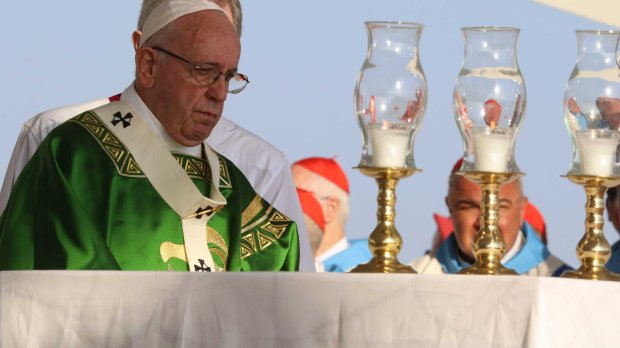In Panama while participating in World Youth Day, Pope Francis gave a very nice gift to the archdiocese of the country’s capital: He himself dedicated the cathedral’s altar. A first on the American continent!
The Catechism of the Catholic Church explains clearly the “two aspects” of the altar: on one hand, it is “the altar of the sacrifice and the table of the Lord,” but on the other, it is also “the symbol of Christ Himself, present in the midst of the assembly of his faithful” (1383). Thus, when we pass in front of an altar, we make a bow out of respect.
In view of its particular vocation to be the table on which bread and wine become the Body and Blood of Christ, the altar must be consecrated. It is this dedication ritual that Pope Francis celebrated on January 26 in St. Mary’s Cathedral, Antigua Panama.
First, relics of saints are embedded in the table. This gesture emphasizes the union of the saints with Christ. In addition, it reminds us that the faith has been passed on from generation to generation. It is also a call to the mission, to announce the Good News.
In Panama, Pope Francis sealed the relics of four saints in the altar. Three of them are saints from Latin America, to whom there is great devotion in this region of the world: St. Martin de Porres, St. Rose of Lima, and St. Oscar Romero.
The fourth relic comes from John Paul II, the first Sovereign Pontiff to visit Panama. He is also the initiator of the WYDs, the gathering during which this altar was dedicated.
The second step is to anoint the altar with holy chrism. The head of the Catholic Church thus poured out a full pitcher of holy chrism on the altar. This is done at the four corners of the altar, pouring the liquid in the shape of a cross. Holy as it may be, this oil stains. This is why the celebrant removes his chasuble before pouring it — especially since once he’s done pouring it, he spreads it carefully over the entire surface of the altar, with his bare hands.
Holy chrism, a blend of oil and perfume, designates one chosen by God. This is why every Christian is marked with this oil at the moment of baptism and confirmation, by a cross traced on the person’s forehead by the priest. The spreading of this oil on the altar therefore marks the holy character of this table. Marking the one who is chosen by God, holy chrism makes Christ “sensed” through a pleasant smell that filled the entire cathedral of Panama.
After the relics and the holy chrism, it is incense’s turn to symbolize the vocation of the altar. Incense is burnt in containers on top of the altar, while it is incensed in a more traditional way, through the use of a censer. This ritual symbolizes the prayers that go up to the Lord, as the curling smoke of incense ascends to heaven.
The altar is then draped with an altar cloth, while lit candles are arranged to show the presence of Christ, light of the world. The dedication rite is only completed with the Eucharistic consecration on the altar, which definitely confirms its vocation.
The ritual of consecration of an altar is, understandably, relatively rare, used especially for the high altar — that is to say, the main altar — of a cathedral.
Panama, which could already boast of being the first Central American country to host the WYD, is the only country in the entire American continent whose altar was consecrated by a Successor of Peter.

